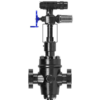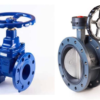You can contact us 24/7 +1(239) 355-5809
When selecting valves for fluid control systems, engineers and facility managers often need to choose between ball valves and gate valves. While both serve the primary function of controlling flow, they operate differently and offer distinct advantages for specific applications. This comprehensive comparison will help you make informed decisions for your next project.
How They Work
Ball Valves operate using a spherical disc (the ball) with a hole through its center. When the valve handle is turned a quarter turn, the hole aligns with or becomes perpendicular to the flow path. When aligned, the valve is open, allowing full flow; when perpendicular, the flow is completely blocked.
Gate Valves function with a flat or wedge-shaped disc (the gate) that moves perpendicular to the flow. When activated, this gate either descends into the flow path (closing the valve) or retracts fully out of it (opening the valve). The gate slides along guiding channels within the valve body.
Key Differences
Flow Characteristics
Ball Valves:
- Provide quick, quarter-turn operation (90° rotation to fully open or close)
- Offer minimal flow restriction when fully open (full port designs)
- Create turbulent flow patterns around the ball
- Excellent for on/off applications with minimal pressure drop
Gate Valves:
- Require multiple turns to fully open or close (slower operation)
- When fully open, create minimal flow restriction with linear flow patterns
- Provide precise flow control during the opening/closing process
- Less likely to cause water hammer effects due to gradual operation
Maintenance Requirements
Ball Valves:
- Lower maintenance needs with fewer moving parts
- Seat rings may require occasional replacement
- Less susceptible to debris accumulation or sediment issues
- Self-cleaning design as the ball rotates past the seats
Gate Valves:
- Higher maintenance due to more intricate internal components
- Stem threads and seals require regular inspection
- Prone to sediment buildup in the body cavity
- Susceptible to stem and seat wear from frequent partial operation
Pressure and Temperature Ratings
Ball Valves:
- Excellent for high-pressure applications
- Available in configurations suitable for extreme temperatures
- Better sealing capabilities under varying pressure conditions
- More compact design while maintaining pressure capabilities
Gate Valves:
- Traditional choice for high-temperature steam applications
- May experience thermal expansion issues affecting sealing
- Typically larger and heavier for the same pressure rating
- Can handle high pressures but with larger physical footprint
Ideal Applications
Ball Valves Excel In:
- Quick shutoff requirements
- Applications with infrequent operation
- Systems requiring bubble-tight shutoff
- Space-constrained installations
- Cryogenic services
- Natural gas and petroleum applications
Gate Valves Are Preferred For:
- Applications requiring gradual flow control
- Systems with solid particles in the media
- High-temperature steam services
- Straight-line flow with minimal pressure drop
- Applications where throttling is occasionally needed
- Municipal water systems
Cost Considerations
Generally, ball valves tend to be more economical for smaller sizes, while gate valves may offer cost advantages in larger diameters. However, when considering lifetime costs including maintenance, repairs, and downtime, ball valves often provide better long-term value despite potentially higher initial investments.
Conclusion
The choice between ball valves and gate valves ultimately depends on your specific application requirements. Ball valves offer quick operation and reliable sealing with minimal maintenance, making them ideal for on/off service. Gate valves provide straight-through flow paths and gradual operation suitable for throttling applications where controlling flow rate is important.
By understanding these fundamental differences, you can select the valve type that best suits your system’s pressure requirements, temperature conditions, operational frequency, and maintenance capabilities.
Recent Posts
- Ball Valve vs. Gate Valve: Understanding the Differences
- Actuated Ball Valves and Butterfly Valves Troubleshooting and Maintenance
- What Is a Cameron Type FLS Hydraulic Gate Valve and Why It’s Important for Frac Operations
- Why the BV89OEP-45 2-Way Butterfly Valve is Most Suitable for Industrial Application






